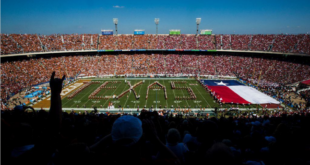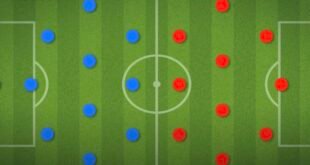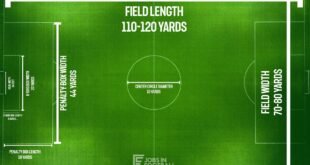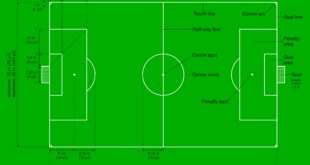A professional soccer field is typically between 100 and 130 yards long and 50 and 100 yards wide. The International Football Association Board (IFAB) sets these dimensions.
Exploring the vast expanse of a professional soccer field offers an exhilarating sense of space and strategy that is central to the game. These fields conform to regulations set by IFAB, ensuring a consistent stage for the drama of the sport to unfold.
Prospective players and enthusiasts alike appreciate knowing the precise scale of the playing area, as it impacts the game’s dynamics, from pacing to player formation. Coaches and teams utilize every inch of the field to their advantage, making its size a critical aspect of soccer tactics. The sheer size contributes to the physical demand of the sport, making it as much an athletic challenge as it is a strategic one. Understanding these dimensions is essential for anyone with a keen interest in professional soccer, as they affect everything from the layout of play to the fitness levels required for players to compete at their best.
🔴How Big is a Professional Soccer Field🔴
Table of Contents
Introduction To Soccer Field Dimensions
The expanse of green that makes up a professional soccer field is more than just a playing surface; it’s the stage where athletes perform spectacular feats of skill and endurance. Understanding the dimensions of a soccer field is essential, not just for the players, but for coaches, referees, and fans who cherish the beautiful game. Optimal sizes ensure fair play, the feasibility of strategic plays, and adherence to international regulations.
Why Size Matters In Soccer
The size of a soccer field can greatly affect the quality of a game. A larger field may favor teams with strong endurance and tactical longevity, while a smaller pitch can benefit those with quick passing skills. Size influences the following:
- Player stamina: Larger fields require more energy to cover.
- Game tactics: Space availability impacts strategic plays.
- Scoring opportunities: Field size can affect the number of goals.
- Spectator enjoyment: Fans appreciate games with dynamic space utilization.
Regulation Sizes Around The World
Different leagues and federations across the globe adhere to specific soccer field dimensions. FIFA sets forth guidelines to maintain consistency in professional soccer:
| Organization | Length (Yards) | Width (Yards) |
|---|---|---|
| FIFA | 100 to 130 | 50 to 100 |
| UEFA | 110 to 120 | 70 to 80 |
| MLS | 110 to 120 | 70 to 80 |
These measurements ensure fields are neither too large nor too small, offering a balanced field for international matches. Clubs and national teams must measure their fields to line up with these standards for official games.
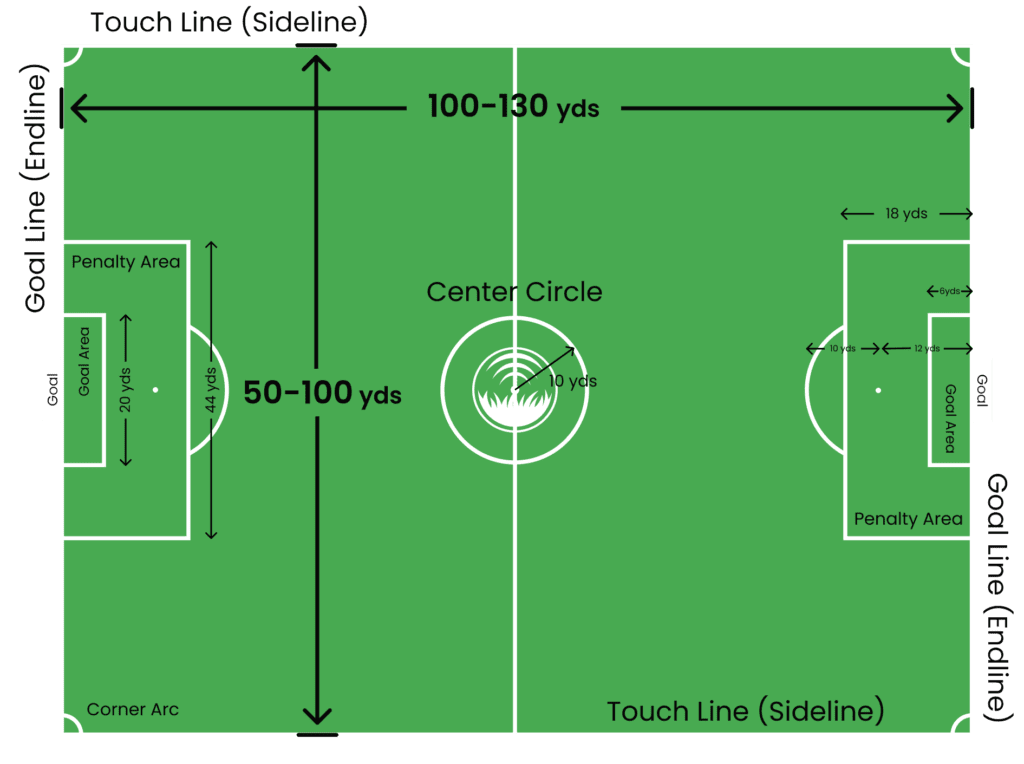
Fifa Standards For Professional Play
When we talk about professional soccer, FIFA standards set the stage. These guidelines ensure that every professional game unfolds on a pitch that meets strict size criteria. Knowing the size of a professional soccer field helps in understanding the game better. So, what are these FIFA regulations for professional play? Let’s explore.
Length And Width Requirements
According to FIFA, a professional soccer field must follow specific dimensions. The length of the field should be between 100 yards (90 meters) and 130 yards (120 meters). The field’s width must range from 50 yards (45 meters) to 100 yards (90 meters). These measurements ensure adequate playing space for top-level matches.
| Part of Field | Minimum Size | Maximum Size |
|---|---|---|
| Length | 100 yards (90 meters) | 130 yards (120 meters) |
| Width | 50 yards (45 meters) | 100 yards (90 meters) |
Tolerance And Flexibility In Measurements
FIFA acknowledges that not all stadiums can have the same dimensions. Therefore, some flexibility is allowed. The rules provide a range of acceptable measurements. This tolerance ensures that various stadiums can host international matches, even if their playing fields have slight size variations.
- Fields must stay within the prescribed size range.
- Variations account for different stadium designs and sizes.
- The size must be consistent with the game’s integrity and fairness.
Comparing League Variations
Professional soccer fields vary in size across different leagues. From Europe to America, field dimensions differ. This section explores the sizes and outlines the key differences.
European Fields Vs. American Fields
Soccer fields in Europe and America follow guidelines from FIFA and their respective regional bodies. European fields often meet FIFA’s maximum size, measuring up to 110 meters in length and 75 meters in width.
In contrast, American fields may be slightly smaller. They align with the United States Soccer Federation’s (USSF) standards, which align with FIFA’s minimum requirements. A typical American professional soccer field is about 100 meters long and 70 meters wide.
Key differences include:
- FIFA maximum dimensions: 110m by 75m
- USSF standard dimensions: 100m by 70m
Adjustments For Multi-use Stadiums
Multi-use stadiums can alter soccer field dimensions. These stadiums often host various events, from concerts to other sports.
Stadiums adapt their field sizes to fit other sports, like American football. Soccer fields must be resized, hence not reaching FIFA’s maximum standards.
Multi-use stadiums feature:
- Convertible designs: To accommodate multiple sports
- Fields adhering to the smallest standard sizes
Components Of A Soccer Field
Understanding the size and components of a professional soccer field is key to grasping the game’s rules and dynamics. A standard pitch not only adheres to rigorous size specifications but also includes well-defined areas that are crucial during play. To fully appreciate the game, it’s important to know about the markings and what happens in each box on the field.
Pitch Markings And Their Significance
The lines on the soccer field are not just for show; they guide play and keep order. Each line serves a purpose, marking boundaries and key spots for game events. Here’s a breakdown:
- Touchlines: The longest field lines, define the sides.
- Goal lines: shorter boundary lines at each end where goals sit.
- Center circle: defines kickoff space and ensures opposing players keep their distance during kickoffs.
- Halfway line: splits the field, with a center spot for kickoffs.
- Corner arc: marks a spot for corner kicks, curving at each corner.
Goal Area And Penalty Box Specifics
The goal area and penalty box are critical, impacting play and outcomes. Let’s highlight their specifics:
| Area | Size (yards) | Function |
|---|---|---|
| Goal Area | 6 x 20 | Where goal kicks start. |
| Penalty Area | 18 x 44 | Zone for penalty kicks and goalkeeper handling. |
Within the penalty area, the penalty spot sits 12 yards from the goal, marking where penalties are taken. The arc outside the box ensures players stay back during penalties. These areas are key for scoring chances or defending against them. Knowing their dimensions and rules helps to understand strategies and fouls.
Influences On Field Size
Many factors influence the size of a professional soccer field. While rules set standard dimensions, real-world aspects often affect the actual field size. Let’s explore these influences.
Impact Of Stadium Constraints
Stadiums are unique. Space can be tight in urban areas, leading to smaller fields. Teams may adjust field sizes within regulations to fit their strategies or to accommodate the stadium’s design.
Climatic Considerations And Field Size
Weather patterns play a role in field size too. In regions with heavy rainfall, larger fields can become waterlogged. To manage this, groundskeepers may opt for slightly smaller playing surfaces to ensure the pitch remains playable throughout the season.
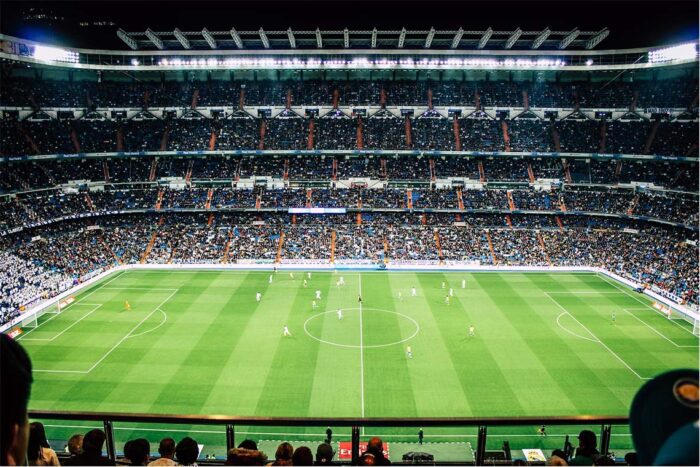
Field Size And Game Play
Understanding field size in soccer is more than just numbers. It’s about how the game unfolds on the pitch.
Soccer fields vary in size. They influence the speed and flow of the match. Players must adapt to the dimensions. These spaces are where magic happens. Let’s explore how size shapes the game.
How Dimensions Affect Playing Style
Field dimensions can dictate a team’s strategy. They impact how players move and pass. Smaller fields mean quicker plays. Larger fields allow more space to run and create chances.
- Narrow fields lead to tight games.
- Wide fields favor expansive play.
Advantages Of Bigger Vs. Smaller Fields
Teams must know their field’s size. It helps them plan better.
| Field Size | Advantages |
|---|---|
| Bigger Fields |
|
| Smaller Fields |
|
Maintenance Challenges Of Larger Fields
Maintaining a professional soccer field is no small feat, especially when it covers an expanse as large as 8,000 square meters, which is typical for larger fields. These vast areas present a host of maintenance challenges that ground staff must tackle to ensure the pitch is in top condition for match day. Consistent care is vital for the turf’s health and the players’ performance and safety.
Grass Type And Upkeep
Different grass types demand distinct maintenance routines. Bermuda grass and Kentucky bluegrass are common choices for soccer fields due to their durability and recovery rate. Choosing the right grass is crucial; it influences mowing, fertilizing, and reseeding schedules.
Here’s a breakdown of the typical care for these grass types:
- Mowing: 2-3 times per week, keeping it at a height of 2-3 inches.
- Fertilizing: monthly, to supply essential nutrients.
- Reseeding: annually or as needed to ensure dense turf.
Irrigation And Drainage Systems
Irrigation systems must be effective and precise to prevent waterlogging or drought stress. Larger fields often use in-ground sprinkler systems that distribute water evenly across the field.
| Irrigation System Feature | Benefit |
|---|---|
| Programmable settings | Customized watering schedules |
| Rain sensors | Prevent overwatering after rain |
| Even coverage | Eliminate dry spots |
Drainage systems are also pivotal in protecting the field from heavy rain. A well-designed drainage system includes layers of sand and gravel beneath the turf, allowing rapid water movement away from the playing surface.
Periodic assessment and cleaning of these systems ensure their optimal performance and longevity. Consequently, this protects the field from damages that could arise from poor water management.
Technological Advances In Field Design
The world of professional soccer constantly evolves, with technology shaping the way we experience the game. This evolution isn’t limited to how we watch matches or keep score; it has significantly impacted field design and maintenance. Let’s delve into how modern technology ensures playing fields meet professional standards and offer optimal performance conditions for athletes.
Hybrid Turf Innovations
Imagine grass that stays green and resilient, no matter how many cleats trample across it. This is the magic of hybrid turf, a fusion of natural grass and synthetic fibers. Using advanced weaving techniques, manufacturers create pitches that can withstand intense play while offering a natural ball roll.
- Enhanced durability ensures less wear and tear.
- A consistent playing surface allows for better game quality.
- These fields require less maintenance than traditional grass, saving time and resources.
Precision Measurement Tools
In the pursuit of perfection, precision is king. With high-tech measurement tools, groundskeepers now map out every inch of the soccer pitch. Laser-guided devices and GPS technology enable them to lay out lines with pinpoint accuracy.
Key benefits include:
- Fields perfectly align with regulatory standards.
- Even turf growth is maintained for a level playing field.
- Optimal drainage patterns can be designed to avoid water logging.
These advancements contribute to the awe-inspiring quality and beauty of modern professional soccer fields, setting the stage for the world’s beloved game to unfold.
Famous Fields And Their Dimensions
Professional soccer fields are not one-size-fits-all.
Each stadium has its own unique set of dimensions.
Let’s explore some iconic soccer fields.
We will see how their sizes stack up.
Iconic Stadiums And Their Sizes
Dive into the heart of soccer’s heritage with some iconic stadiums:
- Wembley Stadium: This legendary field in London measures 105m x 68m.
- Maracanã: In Rio de Janeiro, this vast space spans 105m x 68m.
- Camp Nou: FC Barcelona’s home ground outstretches to 105m x 68m.
These figures align with FIFA’s recommended dimensions.
They are approximately 115 yards by 74 yards.
Historical Changes In Field Sizes
Over time, soccer field dimensions have evolved:
- Early Days: Fields had no standard size.
- Modern Era: Standardization began for fair play.
- Regulations: Now, FIFA sets strict limits on field dimensions.
Older stadiums might have odd sizes.
Newer ones follow FIFA’s recommendations more closely.

Conclusion: The Role Of Field Size In Soccer
The size of a professional soccer field plays a pivotal role in the dynamics of the game. Not only does it influence player performance, but it also impacts team strategies. With these factors in mind, let’s dive into the significance of field size in the world of soccer.
Balancing Tradition With Modern Requirements
Soccer boasts a rich history that deeply values tradition. The dimensions of the field are part of this heritage. Field sizes vary, but they must meet regulatory standards. While tradition is respected, there is a growing need to balance this with modern soccer’s evolving requirements. Player fitness levels and tactical developments necessitate an adaptable approach to field dimensions.
- Standardization ensures fair play.
- Modern training techniques address varying field sizes.
- Players must adapt to different configurations.
The Future Of Soccer Field Dimensions
As soccer continues to progress, discussions about the potential for changing field dimensions arise. Innovations in play, player abilities, and viewer preferences may shape future field sizes.
| Aspect | Current Trends | Possible Changes |
|---|---|---|
| Play Style | Fast-paced games | Larger pitches for expansive play |
| Player Fitness | High stamina and agility | Field sizes to test physical limits |
| Technology | Enhanced viewing experience | Adjustments for broadcast quality |
Rule-making bodies will consider these factors. Whether fields grow or shrink, the essence of the game must remain intact. The main target is to ensure that soccer continues to thrive and appeal to fans worldwide.
Exciting times lie ahead for soccer. Field dimensions will undoubtedly be part of the evolution of this beloved sport.
Frequently Asked Questions Of How Big Is A Professional Soccer Field
What is a standard FIFA soccer field size?
Professional soccer fields conform to FIFA standards, measuring 100–110 meters in length and 64–75 meters in width. This equates to a maximum area of approximately 8,250 square meters.
Are there size variations on soccer fields?
Yes, soccer field dimensions can vary within FIFA’s prescribed range. This allows pitches to accommodate different stadium sizes and meet international, national, or local league requirements while maintaining regulated play areas.
How does pitch size affect soccer gameplay?
Larger pitches can favor teams that excel in stamina and strategic spacing, promoting a wide attacking game. Smaller fields may benefit teams with tight, short-passing play styles, intensifying player interactions and requiring less running.
What is the minimum size for a soccer field?
The smallest acceptable dimensions for a professional soccer field are 100 meters in length and 64 meters in width, following FIFA guidelines. This ensures that all professional matches maintain a consistent playing space.
Conclusion
Understanding the size of a professional soccer field can significantly impact players, coaches, and fans alike. Fields adhere to FIFA’s dimensions, ranging from 100 to 110 meters long and 64 to 75 meters wide. Recognizing these measurements allows for a better grasp of the game’s dynamics and strategies.
 Cric Enjoy Sports News, Cricket Update, Live Streaming
Cric Enjoy Sports News, Cricket Update, Live Streaming

